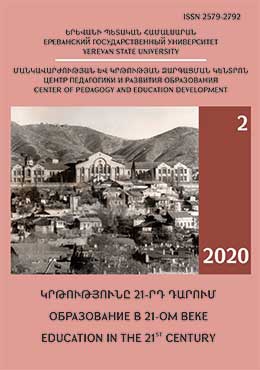OPTICAL-GRAPHICAL DISORDERS IN THE WRITING OF VISUAL IMPAIRED PRIMARY SCHOOLERS
DOI:
https://doi.org/10.46991/educ-21st-century.v2i4.10907Keywords:
visually impaired child, primary school students, op- tic-graphic writing disorders, prevention, correction, teacher, viewer new perception, means, methods, pedagogical approachesAbstract
This article reviews the main optical-graphical disorders of writing in visually impaired
primary schoolers. It is known, that visual impairment significantly complicates the playing,
physical, cognitive, educational, labour and other types of activities of children, their orientation in
macro and micro spaces. Therefore, the role of vision in writing can hardly be overestimated.
The visual control plays a very important role in observing graphical norms, rules and
conditions of writing in the formation and development of visual skills of visually impaired
140
students. In this connection, the study of optical-graphical disorders in the writing of visually
impaired primary schoolers will serve the basis for the development of special pedagogical
approaches and terms of application for the organization and implementation of work aimed at the
prevention and correction of graphical writing disorders of visually impaired primary schoolers.
It is well known, that the formation and development of graphical skills of visually impaired
students is to be started from the first grade, as it is more difficult to correct or eliminate opticalgraphical
writing disorders in higher grades. Thus, the success of all the work depends on the
informative level of primary school's teachers about graphical writing disorders of their students,
the means, methods and conditions of their use for carrying out the prevention and correction
works. This defines the necessity to study optical-graphical writing disorders of visually impaired
primary schoolers and to develop special pedagogical approaches and conditions for the
prevention and correction of these disorders.
References
Ազարյան Ռ. Ն., Տեսողության խանգարում ունեցող անձանց կրթության կազ-
մակերպման հիմունքներ/ Հատուկ մանկավարժություն: Դասագիրք մանկավարժական
բուհերի ուսանողների համար, Երևան, 2016, էջ 125-189:
Մկրտչյան Հ. Ռ., Թույլ տեսնող կրտսեր դպրոցականների գրավոր խոսքի խան-
գարումների շտկողական աշխատանքների օպտիմալացումը/ մանկ. գիտ. թեկնածու ա-
տենախոսության սեղմագիր, Երևան, 2005,18 էջ:
Алимова Л. М., Опыт работы по выявлению нарушений устной и письменной речи
у учащихся общеобразовательных школ//Дефектология, М., 1980, N2, с. 61-63.
Ананьев Б. Г., Анализ трудностей в процессе овладения детьми чтением и письмом.
Известия. АПН РСФСР, вып. 70, 1955, с. 165-169.
Бондаренко А. И., Пути преодоления нарушений письма в процессе обучения
родному языку. Автореф. Дисс.канд. пед. наук, М., 1980, с. 17.
Грушевская М. С., Результаты массового изучения письма младших школьников//
Дефектология, 1981, N3, с. 32-37.
Гурьянов Б. В., Психология обучения письму, М., Изд-во, АПН РСФСР, 1959, с. 89.
Денискина В. З., Азарян К. А., Подходы к оказанию информационной помощи ро-
дителям, воспитывающим ребенка с нарушением зрения//Образование в XXl веке», Между-
народный научно-методический рецензированный журнал, Ереван, 2020, N1, с. 85-91.
Дорофеева Т. А., Особенности использования органов чувств в учебной деятельно-
сти младших школьников с нарушением зрения // Дефектология, М., 2002, N1, с. 14-19.
Земцова М. И., Особенности зрительного восприятия при глубоком нарушении
зрения у детей.-Специальная педагогика, N1(121), 1967, с. 16-21.
Корнев А. Н., Нарушение чтения и письма у детей, СПб., 2003, с. 11-38.
Плаксина Л. И., Развитие зрительного восприятия//В сб. «Программы для специаль-
ных образовательных учреждений, lVвида, М., 1997, с. 44-67.
Психолого-педагогическая характеристика детей с нарушениями зрения. //В кн.
«Специальная педагогика»/Под ред. Л. В. Мардахаева, Е. А, Орловой, М., 2012, с. 121-134.
Kuchumava T. A., Burlakova M. K., Psycho-linguistic aspect of speech disorders in
subcortex layers. // Conference 26-28. 06 Porio, 1997, pp. 78-84.
Downloads
Published
How to Cite
Issue
Section
License

This work is licensed under a Creative Commons Attribution-NonCommercial 4.0 International License.

